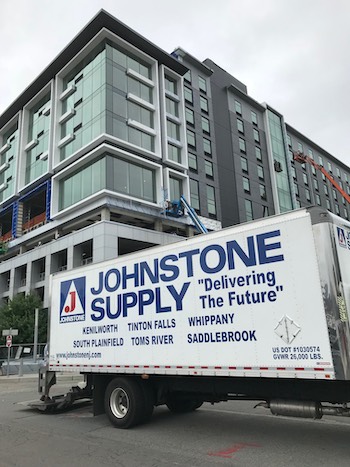
Johnstone Supply assisted Dash Mechanical with VRF training and design support.
It’s been a decade since Captain Chesley Sullenberger glided US Airways Flight 1549 to a soggy emergency landing on the Hudson River.
The plane touched down gently, not far from the Port Imperial Ferry Terminal, in Weehawken, N.J. All 155 passengers and crew members survived. Without being instructed to do so, ferries left their docks and hurried to pull people from the frigid January waters.
“Everyone called it the ‘The Miracle on the Hudson,’” said Keith McGowan, commercial sales associate at Johnstone Supply. “It was 19°F that afternoon, and everyone was fortunate that the ferries were able to get there quickly. The ferries weren’t as busy then as they are now, and the Weehawken shoreline looked much different than it does today.”
When McGowan was a service tech, in the late 90s, the ferry terminal was the only thing on the west shore of the river. Today, construction occurs at a blistering pace.
Conduit to the city
“The Port Imperial Ferry Terminal has become a main aorta for commuters headed into the Big Apple,” he said. “It connects many of New Jersey’s bedroom communities with high-paying jobs in the city. But it wasn’t until more recently that development hit full stride. This past year was the first I’d put my expertise to the test in the construction. I was involved with a unique Fujitsu Airstage VRF installation right beside the ferry terminal.”
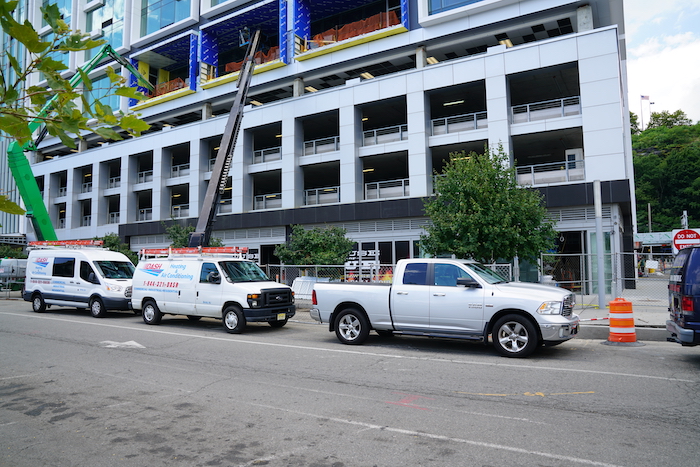
This project was the first VRF system that Dash Mechanical installed.
New condos, daycare facilities and parking garages now fill the streets leading to the ferry terminal, relying completely on the conduit to Manhattan that Port Imperial provides. Construction took place so rapidly that it seems like developers never considered where commuters might stop to grab a bite to eat.
“There are almost no restaurants here,” said McGowan. “When a unique space opened up on the ground floor of a new parking garage directly across from the terminal, a Texas-style barbeque, called House of ‘Que, jumped to make it their own.”
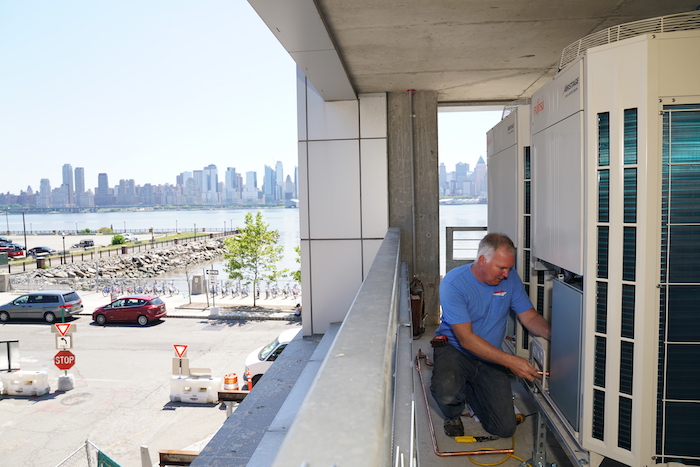
Dave Ashenfelter, president of Dash Mechanical, worked with the mechanical engineer to change the spec to two, smaller VRF condensers instead of one, which the original design called for.
Founded in 2013, House of ‘Que has one existing location in Hoboken, which also overlooks NYC from the far side of the Hudson. The restaurant’s owner knows Dave Ashenfelter, president of Dash Mechanical, and brought him in early on the HVAC system design to address the particular challenges the space presented.
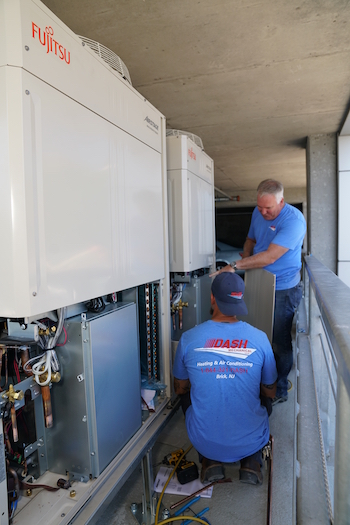
House of Que is heated and cooled by a Fujitsu AirStage VRF system located in a parking garage above the restaurant.
“This is a plan/spec job where we collaborated with the engineer,” said Ashenfelter, whose company focuses on commercial and industrial plumbing and HVAC throughout New Jersey. “Limited space, and the fact that the restaurant sits below a parking garage, made for a lot of unique considerations.”
While the House of ‘Que dining experience—complete with live stage, open-air atmosphere and a menu to die for—will be the same in Weehawken as it is in Hoboken, the mechanical system takes a page from a different playbook.
In Hoboken, the eatery is heated and cooled by a large central system operated by the Port Authority. In Weehawken, owners and managers at the House of ‘Que wanted to keep the mechanical systems in-house, with comfort and efficiency prioritized.
Conditioning unique space
“In the original design, a single VRF condenser was going to serve the entire space,” explained Ashenfelter. “I worked with the engineer to change the spec to two, smaller Fujitsu Airstage VRF systems. The restaurant owner preferred two condensers instead of one. If a condenser fails, the restaurant can at least maintain half its heating or cooling capacity.”
The restaurant is at ground level, and almost the entire front of the venue has folding glass doors that open to the street, and to the view of the city across the river. For roughly nine months of the year, the doors are open. To extend the open-air season and limit the entry of insects and dirt, Johnstone supplied 60 feet of Mars air curtain.
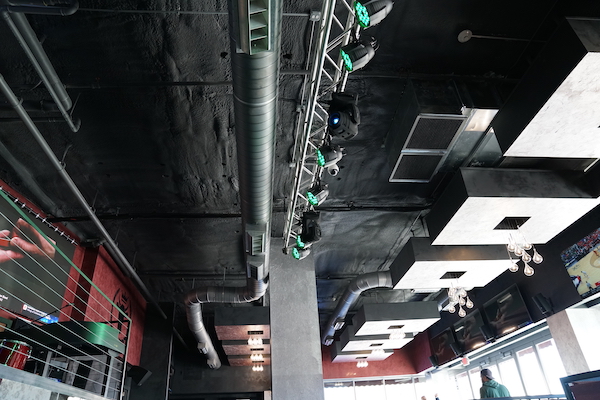
Large, high static air handlers are used to heat and cool the seating area through exposed spiral duct.
“The use of the air curtains causes a wash of air over the entrances to prevent outdoor air from rushing indoors, and helps keep insects from entering,” said McGowan, who has worked on the project with Ashenfelter since the beginning. “Without air curtains, the heating or cooling load would be much higher.”
Table seating is provided at ground level, and the bar area was excavated several feet below grade. A stage and a pair of massive TV screens above the bar are also at street level, providing pedestrians a view of the entertainment inside.
Two, eight-ton high-static Fujitsu Airstage air handlers are used to heat and cool the seating area through exposed spiral duct. An office and locker room space behind the bar is conditioned by a three-ton air handler.
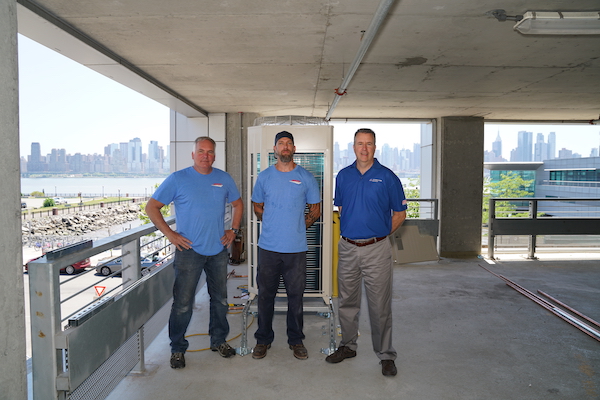
Keith McGowan (R), with Johnstone Supply, visited the construction site frequently during mechanical system installation.
The Fujitsu Airstage condensers—one eight-ton and one 10-ton—are mounted in the parking garage on the second floor, separated from cars by a set of bollards. Even though the parking garage is open to the outside, the ceilings are low enough that the design called for condenser hoods. These are used to discharge air horizontally, out of the parking garage.
A first of many
“I’ve been in the trade for nearly 40 years, and founded Dash Mechanical about five years ago,” said Ashenfelter. “This was our first VRF project, so we were grateful for the Fujitsu factory training, on-site support from Johnstone Supply, and design input from Umair Surani, Mid-Atlantic Sales Engineer at Fujitsu.
“That support made the install easier than I expected, despite the fact that everything inside the restaurant is custom made, and the building is all steel and concrete,” he added.
As soon as Dash was contacted about providing a solution for the restaurant last year, Ashenfelter asked McGowan where to get solid VRF training. Several Dash employees then attended Fujitsu’s VRF training courses over the winter.

Known for its smoked meat dishes, House of ‘Que is located across from the Weehawken Ferry Terminal.
“Keith has been in this industry a long time, and like everyone at Johnstone, he’s always been a great resource,” continued Ashenfelter. “He comes out to jobs anytime I need him, and he’s certified for VRF start-up as well. Johnstone supplies a level of service and expertise that isn’t common among wholesalers.”
Dash stayed one step ahead of construction progress and maintained attention to detail. The use of sound attenuators and purging refrigerant lines with nitrogen before brazing will go a long way to elevate the customer dining experience and ensure long system lifecycle. With the success of the project, Ashenfelter is confident that House of Que will duplicate the system if they open new locations.
The restaurant’s grand opening took place in late November, and if the customer response since then is any indication, expansion may be a serious consideration. In the meanwhile, Dash Mechanical has more VRF projects on the calendar.

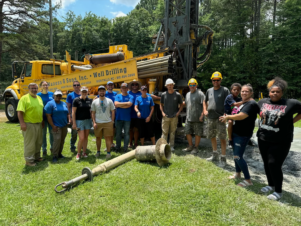

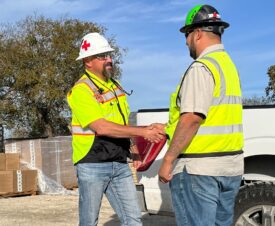
Join the conversation: